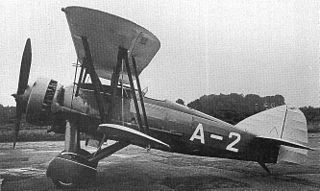 W
WThe Armstrong Whitworth A.W.16 was a British single-engine biplane fighter aircraft designed and built by Armstrong Whitworth Aircraft. A number were sold to the Chinese Kwangsi Air Force.
 W
WThe Armstrong Whitworth A.W.35 Scimitar was a British single-engine biplane fighter aircraft designed and built by Armstrong Whitworth Aircraft. Four Scimitars were produced for the Norwegian Army Air Service and were delivered in 1936.
 W
WThe Blackburn B-25 Roc was a British Second World War-era Fleet Air Arm fighter aircraft designed by Blackburn Aircraft Ltd. It took its name from the mythical bird of the tales of the Arabian Nights, the Roc. Derived from the Blackburn Skua and developed in parallel, the Roc had its armament in a turret. The Roc came to be viewed as inferior to existing aircraft such as the Skua and the type had only brief front-line service.
 W
WThe Blackburn B-24 Skua was a carrier-based low-wing, two-seater, single-radial engine aircraft operated by the British Fleet Air Arm which combined the functions of a dive bomber and fighter. It was designed in the mid-1930s and saw service in the early part of the Second World War. It took its name from the sea bird.
 W
WThe Boulton Paul Defiant is a British interceptor aircraft that served with the Royal Air Force (RAF) during World War II. The Defiant was designed and built by Boulton Paul Aircraft as a "turret fighter", without any forward-firing guns, also found in the Blackburn Roc of the Royal Navy.
 W
WThe Bristol Type 156 Beaufighter was a multi-role aircraft developed during the Second World War by the Bristol Aeroplane Company in the UK. It was originally conceived as a heavy fighter variant of the Bristol Beaufort torpedo bomber. The Beaufighter proved to be an effective night fighter, which came into service with the Royal Air Force (RAF) during the Battle of Britain, its large size allowing it to carry heavy armament and early airborne interception radar without major performance penalties.
 W
WThe Bristol Blenheim is a British light bomber aircraft designed and built by the Bristol Aeroplane Company (Bristol) which was used extensively in the first two years and in some cases throughout the Second World War. The aircraft was developed as Type 142, a civil airliner, in response to a challenge from Lord Rothermere to produce the fastest commercial aircraft in Europe. The Type 142 first flew in April 1935, and the Air Ministry, impressed by its performance, ordered a modified design as the Type 142M for the Royal Air Force (RAF) as a bomber. Deliveries of the newly named Blenheim to RAF squadrons commenced on 10 March 1937.
 W
WThe Bristol Type 123 was a single-seat, single-engine biplane fighter built to a United Kingdom Air Ministry specification for a four-gun fighter in the early 1930s. Only one was built.
 W
WThe Bristol Type 133 was a prototype single-seat, single-engine monoplane fighter, armed with four guns, metal-skinned and with a retractable undercarriage, built by The Bristol Aeroplane Co. to an Air Ministry specification in the mid-1930s. The single example crashed before the trials commenced.
 W
WThe Bristol Type 146 was a British single-seat, eight-gun fighter monoplane prototype built to a mid-1930s Air Ministry contract. Powered by a radial engine, it was outclassed by Merlin-engined fighters and only one was built.
 W
WThe Fairey Fantôme, also known as the Fairey Féroce, was a British fighter prototype of the mid-1930s. The prototype was designed and built by Fairey Aviation and three production aircraft were assembled in Belgium by Avions Fairey.
 W
WThe Gloster Gauntlet was a British single-seat biplane fighter of the RAF, designed and built by Gloster Aircraft in the 1930s. It was the last RAF fighter to have an open cockpit and the penultimate biplane fighter in service.
 W
WThe Gloster Gladiator was a British-built biplane fighter. It was used by the Royal Air Force (RAF) and the Fleet Air Arm (FAA) and was exported to a number of other air forces during the late 1930s.
 W
WThe Hawker Hart was a British two-seater biplane light bomber aircraft of the Royal Air Force (RAF). It was designed during the 1920s by Sydney Camm and manufactured by Hawker Aircraft. The Hart was a prominent British aircraft in the inter-war period, but was obsolete and already side-lined for newer monoplane aircraft designs by the start of the Second World War, playing only minor roles in the conflict before being retired.
 W
WThe Hawker Fury was a British biplane fighter aircraft used by the Royal Air Force in the 1930s. It was a fast, agile aircraft, and the first interceptor in RAF service capable of speed higher than 200 mph. It was the fighter counterpart to the Hawker Hart light bomber.
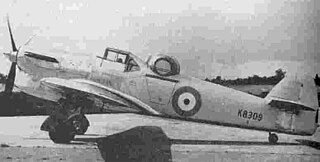 W
WThe Hawker Hotspur was a Hawker Henley redesigned to take a Boulton-Paul semi-powered four gun turret. It was designed in response to Air Ministry Specification F.9/35, which required a powered turret as the main armament to replace the Hawker Demon.
 W
WThe Hawker Hurricane is a British single-seat fighter aircraft of the 1930s–40s that was designed and predominantly built by Hawker Aircraft Ltd. for service with the Royal Air Force (RAF). It was overshadowed in the public consciousness by the Supermarine Spitfire's role during the Battle of Britain in 1940, but the Hurricane inflicted 60 per cent of the losses sustained by the Luftwaffe in the engagement, and fought in all the major theatres of the Second World War.
 W
WThe Hawker Nimrod was a British carrier-based single-engine, single-seat biplane fighter aircraft built in the early 1930s by Hawker Aircraft.
 W
WThe Martin-Baker MB 2 was a British private-venture fighter prototype based on a simple basic structure that had been developed in the earlier MB 1 civil aircraft. Although briefly evaluated as a fighter by the Royal Air Force, the MB 2 was limited in design potential and never entered series production.
 W
WThe Supermarine Spitfire is a British single-seat fighter aircraft that was used by the Royal Air Force and other Allied countries before, during, and after World War II. Many variants of the Spitfire were built, using several wing configurations, and it was produced in greater numbers than any other British aircraft. It was also the only British fighter produced continuously throughout the war. The Spitfire continues to be popular among enthusiasts; nearly 60 remain airworthy, and many more are static exhibits in aviation museums throughout the world.
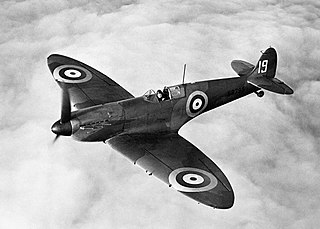 W
WThe British Supermarine Spitfire was one of the most popular fighter aircraft of the Second World War. The basic airframe proved to be extremely adaptable, capable of taking far more powerful engines and far greater loads than its original role as a short-range interceptor had allowed for. This would lead to 24 marks of Spitfire, and many sub-variants within the marks, being produced throughout the Second World War and beyond, in continuing efforts to fulfill Royal Air Force requirements and successfully combat ever-improving enemy aircraft.
 W
WThe British Supermarine Spitfire was the only Allied fighter aircraft of the Second World War to fight in front line service from the beginnings of the conflict, in September 1939, through to the end in August 1945. Post-war, the Spitfire's service career continued into the 1950s. The basic airframe proved to be extremely adaptable, capable of taking far more powerful engines and far greater loads than its original role as a short-range interceptor had called for. This would lead to 19 marks of Spitfire and 52 sub-variants being produced throughout the Second World War, and beyond. The many changes were made in order to fulfil Royal Air Force requirements and to successfully engage in combat with ever-improving enemy aircraft. With the death of the original designer, Reginald J. Mitchell, in June 1937, all variants of the Spitfire were designed by his replacement, Joseph Smith, and a team of engineers and draftsmen.
 W
WThe Supermarine Spitfire, the only British fighter to be manufactured before, during and after the Second World War, was designed as a short-range fighter capable of defending Britain from bomber attack and achieved legendary status fulfilling this role during the Battle of Britain. According to fighter ace J.E. "Johnnie" Johnson it was the best conventional defensive fighter of the war.
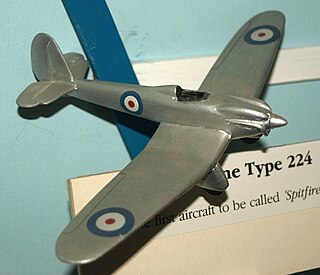 W
WThe Supermarine Type 224 was an inverted gull-wing monoplane fighter aircraft designed by R.J. Mitchell at Supermarine in response to Air Ministry Specification F.7/30, which sought a fighter for introduction to succeed the Gloster Gauntlet. It was powered by the Rolls-Royce Goshawk engine, which used an experimental evaporative cooling system, and problems with this system, combined with its disappointing performance, led to it being rejected, a contract for production aircraft eventually going to the Gloster Gladiator. It is nevertheless notable because R.J. Mitchell learnt lessons from its failure that were to contribute greatly to his success with the Supermarine Spitfire.
 W
WThe Vickers Type 151 Jockey was an experimental low-wing monoplane interceptor fighter powered by a radial engine. It was later modified into the Type 171 Jockey II, which had a more powerful engine and detail improvements. Only one was built; it was lost before its development was complete, but the knowledge gained enabled Vickers to produce the more refined Venom.
 W
WThe Vickers Type 161 was an unusual 1930s pusher biplane interceptor, designed to attack aircraft from below with a single upward-angle large calibre gun. The aircraft flew well but the concept was abandoned and only one was built.
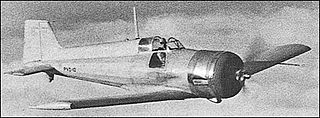 W
WThe Vickers Type 279 Venom was a British low-wing monoplane single-seat, single-engined, eight-gun fighter, powered by a radial engine. Intended for use in hot climates, it was fast and manoeuvrable but its engine lacked the power and development potential of Rolls-Royce Merlin-powered designs and it and other designs to the same specification - Bristol Type 146, Gloster F.5/34, and Martin-Baker MB 2 - were passed over with only one built.
 W
WThe Westland C.O.W. Gun Fighter was an attempt to produce a fighter aircraft armed with a heavy calibre gun. The Coventry Ordnance Works (COW) 37 mm automatic gun was used, which had been developed for this purpose some years earlier.
 W
WThe Westland Whirlwind was a British twin-engined heavy fighter developed by Westland Aircraft. A contemporary of the Supermarine Spitfire and Hawker Hurricane, it was the first single-seat, twin-engined, cannon-armed fighter of the Royal Air Force.
 W
W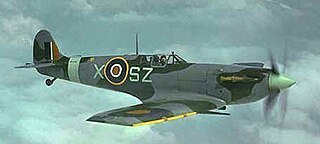 W
W W
W